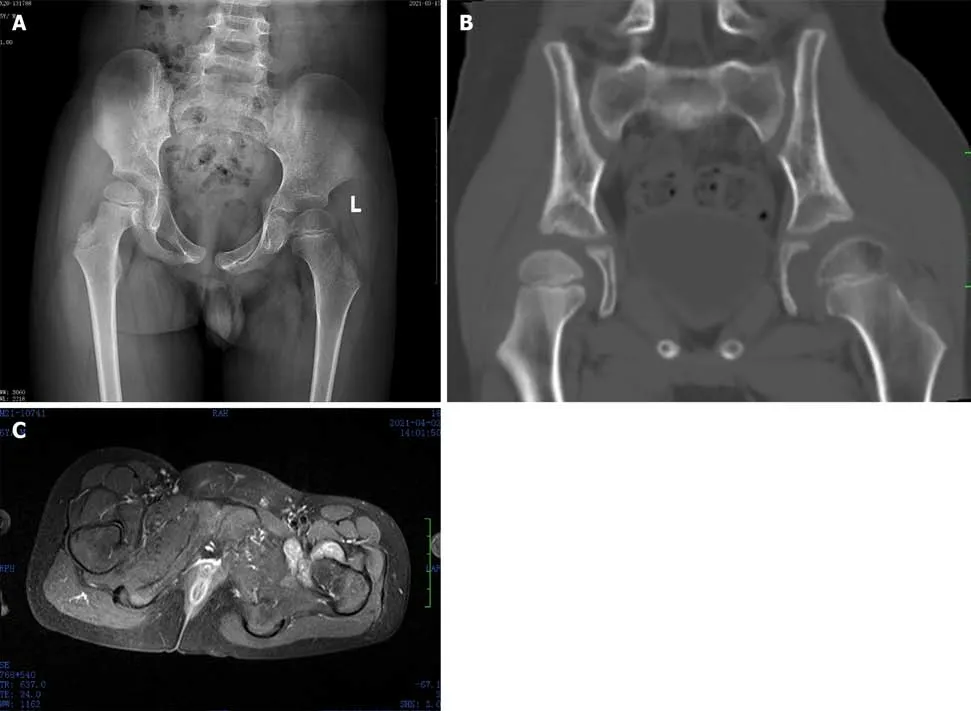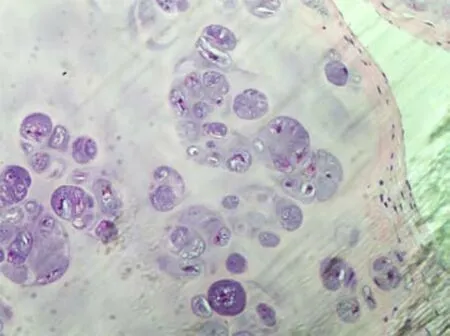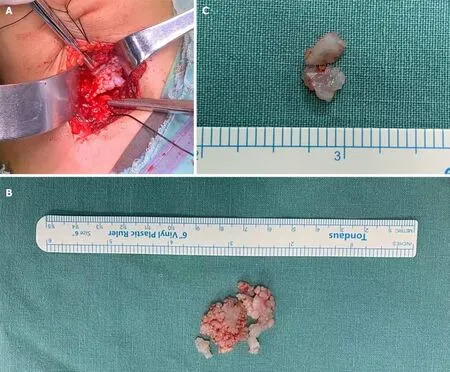Synovial chondromatosis of the hip joint in a 6 year-old child:A case report
INTRODUCTION
Pain accompanied by claudication is a common complaint of hip joint disease in children.Routine imaging examination is often nonspecific.Early and correct diagnosis has a marked influence on the prognosis and function of the hip joint in children.
Synovial chondromatosis (SC) is a benign tumor secondary to synovial chondroma.It occurs mostly in men aged 30-50 years and is very rare in children.SC can be classified into primary and secondary SC.Primary SC occurs with no history of osteoarticular diseases,while secondary SC occurs in the presence of pathological changes,such as osteoarthritis,rheumatoid arthritis,and bone degeneration[1].SC frequently involves a single joint.The knee joint is the most commonly affected joint,followed by the hip joint,elbow joint,shoulder joint,and ankle joint;33 areas have been reported to be involved[2].The most common symptoms of SC are joint pain,swelling,and limited motion.Diagnosis is mainly based on imaging;Seventy percent of patients with SC have calcified nodules on X-ray and computed tomography (CT)examinations,while some patients may not have obvious calcification and nodules in the early stage.
The Afrikakorps commander, Gen. Erwin Rommel, shrewdly saw the song as a means to rally his men. He ordered “Lili” played every night. At 9:55 each evening the song became Radio Belgrade s sign-off and cast its magic spell almost until the war s end.
A 6-year-old child with hip pain and claudication was admitted to our hospital.Xray of the hip in this child was nonspecific.Combined with physical and magnetic resonance examinations,the patient was diagnosed with synoviochondroma of the left hip joint.SC was confirmed by surgery and pathologic examination.
CASE PRESENTATION
Chief complaints
A 6-year-old male patient was admitted to hospital due to left hip joint pain and claudication.
Past medical history was negative.
History of present illness
He was admitted to the hospital due to left hip joint pain and claudication for more than 1 year.He was diagnosed with left hip joint synovitis in other hospitals.He was advised to rest in bed,but his symptoms did not significantly improve.Later,he was diagnosed with left femoral head avascular necrosis and underwent external fixation with bracing.His symptoms did not significantly improve,and the pain and claudication were aggravated.
History of past illness
The next day when she had seated herself at table with the King and all the courtiers, and was eating from her little golden plate, something came creeping splish splash, splish splash, up the marble staircase, and when it had got to the top, it knocked at the door and cried, Princess, youngest princess, open the door for me. She ran to see who was outside, but when she opened the door, there sat the frog in front of it. Then she slammed the door to, in great haste, sat down to dinner again, and was quite frightened. The King saw plainly that her heart was beating violently, and said, My child, what art thou so afraid of? Is there perchance a giant outside who wants to carry thee away? Ah, no, replied she. It is no giant but a disgusting frog.
Laboratory examinations were within normal ranges,including erythrocyte sedimentation rate,white blood cell count,and levels of C-reactive protein,rheumatoid factor,and tumor markers.Routine urinary testing was also normal.
Personal and family history
B-ultrasound showed left hip joint effusion.X-ray showed slight flattening of the left femoral head (Figure 1A).CT showed a decrease in the density of the left hip joint epiphysis and widening of the left hip joint space (Figure 1B).Magnetic resonance imaging (MRI) showed synovial thickening of the left hip joint (Figure 1C).
Physical examination
No sooner was this done than the Wizard King was seen in the air under the form of some unknown bird, exclaiming as he flew off that he would never forgive either his son or the Fairy the cruel wrong they had done him
Laboratory examinations
In a clear, strong voice, Sonali sang to her fellow passengers. She then walked up and down the aisle with one of the crewmembers, receiving the smiles, thanks and love of all the United passengers. At the end of the flight, who stood on top of a box at the door with the flight attendant, thanking everyone and saying good-bye? Our Sonali!
Imaging examinations
Personal and family history,medication history,social history,and allergic history were negative.

FINAL DIAGNOSIS
Biopsy confirmed SC (Figure 2).
No obvious swelling of the left hip joint was observed,with asymmetric groin lines,low skin temperature,local tenderness,pelvis tilting to the left,and unequal length of lower limbs of about 1.5 cm.The left hip joint internal rotation,external rotation,and flexion were limited,with left Allis sign (+),Thomas sign (+),and 4-character sign (+).

TREATMENT
SC is a rare benign lesion first reported by Ambrose Pare in 1558[3].SC is most commonly seen in the knee joint,followed by the hip joint and elbow joint.It is characterized by the presence of multiple pearl-like osteochondral bodies in the joint.

OUTCOME AND FOLLOW-UP
After the surgery,the pain and limp symptoms disappeared.At the 6-wk follow-up,pain and limping had disappeared,and the range of motion of the hip joint was restored to a normal level.
DISCUSSION
The patient underwent an open biopsy and curettage of the lesion with orthopedic surgery under general anesthesiaa bikini incision of the left hip.After the skin tissue was cut,the hip capsule was revealed by turning down the rectus femoris through the gap between the tensor fasciae latae and the sartorius muscle.The hip capsule was cut along the acetabulum direction.Several irregular,milky white cartilage-like granules (Figure 3A) were seen in the articular cavity,with a maximum size of 2 cm × 2 cm × 0.5 cm.The hip joint was moved,and the cartilage particles were thoroughly cleaned.The hip joint was explored,the left femoral head was slightly flattened,and the synovial tissue showed proliferation and thickening.The sizes of the free bodies were different in block connection;the color was white or milky white;the surface was smooth (Figure 3B);the texture was tough,cartilage-like,and elastic;and the inside of the free bodies was solid without liquid outflow (Figure 3C).
After the holiday, poor George decided to buy another leather pair. Before boarding the subway, he stepped into Value Mart again to see if by any chance his gloves had been returned to the lost and found office. What colour are they? the woman in the office asked again. Black, he gave the same answer. She looked into her drawer and drew out a pair of men s leather gloves. Are they??
The disease most commonly occurs in men aged 20-40 years[4],but its incidence is very low;the incidence in children is even lower.Hence,the literature on SC in children is in the form of case reports (Table 1).In 1983,Pelker[5] reported an 11-year-old boy who underwent synoviochondroma resection of the hip joint,with good postoperative effect.In the same year,Carey[6] reported two cases of knee joint synoviochondroma,in children aged 9 years and 10 years,and both underwent synovectomy.In 1991,Kistler[7] reported one case of knee joint synoviochondroma.In 2006,Tiedjen[8] reported a 9-year-old patient who underwent arthroscopic treatment without follow-up results.In 2014,Ali[9] reported the case of a 12-year-old female child who underwent arthroscopic synovectomy at the hip joint.In 2017,Manesh[10] reported a 7-year-old girl who underwent arthrotomy through an anterolateral approach.In 2018,Wen[11] reported a 7-year-old male child who underwent synovial chondroma resection of the hip joint.In this case,after 6 wk of postoperative follow-up,the symptoms of pain and claudication disappeared,and the range of motion of the hip joint returned to normal.Our case was the youngest child with SC of the hip reported in the English literature.We performed open synovectomy and removal of the free bodies in the hip lesion;in a subsequent follow-up,his hip pain and claudication symptoms completely disappeared.

The etiology of cartilage tumors is not clear.It is speculated that the connective tissue under the synovial tissue metastasizes into cartilage cells,followed by cartilage ossification,to gradually produce cartilage nodules.These nodules are nourished by the joint fluid and gradually enlarge.Most of the cartilage nodules are later calcified or ossified.Milgram[12] described the classification of SC based on the location of intraarticular free bodies and pathological findings of synovial and free bodies.He described the first stage as an active intrasynovial lesion with microscopic metaplasia of intrasynovial chondromatosis and no gross abnormalities.The second stage was a transitional intrasynovial lesion with synovial osteochondroma and free bodies.The pedicled cartilage bodies could be seen overhanging the synovial membrane without falling off.The third stage was the synovial lesion and the formation of cartilaginous or osteochondral free bodies.The difference in the present case was that obvious isolated bodies were not formed (Figure 3A),but lumps with irregular shapes developed.According to the classification by Milgram,we suggest that the lumps in our case might be the previous form of synovial osteochondroma and free bodies in the second stage.
Imaging examination plays an important role in diagnosing synovial osteochondroma,with calcification occurring in 70%-95% of cases.Multiple calcifications were found in the capsule of the affected joint,which were usually smooth,round,and of different sizes;the imaging manifestations of free bodies with "annular and arcshaped" chondroid mineralization strongly suggested SC[13].In this case,no cartilaginous nodules and calcification were observed in the synovial tissue of the patient;also,no positive findings of the disease were reported during X-ray and CT examinations.This patient was misdiagnosed in several hospitals as transient synovitis of the hip or ischemic necrosis of the femoral head.The conventional MRI result showed the hip joint full of liquid,and the morphology of the free bodies was not specific enough to diagnose SC (Figure 1C).A study showed that dynamic T1-weighted imaging could be used along with intravenous chelation to enhance synovial tissue,and then to distinguish synovial tissue from SC[14].Due to the dead area in the visual field of conventional hip arthroscopy,a single approach could not completely remove the pathological synovial tissue and the widely existing free bodies,thus easily leading to reoperation due to the high recurrence rate.Therefore,we chose open surgery to completely remove the pathological synovial tissue and free bodies.No signs of recurrence were noted,and satisfactory follow-up results were obtained.Therefore,it is also difficult to identify the hip joint effusion.
CONCLUSION
When we encounter children with hip pain and claudication,increased vigilance and comprehensive physical and imaging examinations should be considered,in order to avoid misdiagnosis and delayed treatment in patients.
 World Journal of Clinical Cases2022年2期
World Journal of Clinical Cases2022年2期
- World Journal of Clinical Cases的其它文章
- New trends in treatment of muscle fatigue throughout rehabilitation of elderlies with motor neuron diseases
- What emotion dimensions can affect working memory performance in healthy adults? A review
- Quadrilateral plate fractures of the acetabulum:Classification,approach,implant therapy and related research progress
- Methylprednisolone accelerate chest computed tomography absorption in COVID-19:A three-centered retrospective case control study from China
- Analysis of photostimulable phosphor image plate artifacts and their prevalence
- N6-methyladenine-modified DNA was decreased in Alzheimer’s disease patients
